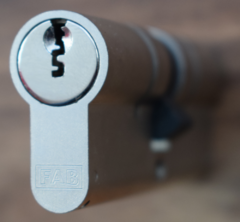FAB Control
FAB Control
| FAB Control 2224BDN | |
 | |
| Name | FAB Control 2224BDN |
|---|---|
| Manufacturer | Fab |
| Lock Type | Cylinder |
| Lock Design | Pin-tumbler |
FAB Control was FAB's first attempt to protect key profile by law. It was meant that FAB would be the only manufacturer of the blanks and locksmith would copy or cut a key only after being presented with the security card.
Unfortunately when the lock proliferated enough, another manufacturer started producing blanks, that were changed a bit, which was enough to render the whole protection useless. In reaction to that FAB allowed free blank distribution and security card was no longer necessary to copy a key, effectively throwing their customers overboard.[1]
Description
The lock contains five pin stacks, with two chambers containing standard drivers and the rest contain spools.
The core has a wide overmilling on chamber 5, that is called nuta, which serves as a protection against dynamic methods like bumping. In principle, when the lock was subjected to a dynamic attack, and the gap is created between the key pin and the driver, the core starts to rotate; but before it rotates far enough, the driver springs back and gets caught in the overmilling. As a protection, its success rate was below 50%, and even when it did work, bypassing it by pushing on the last pin was trivial. Nuta started to appear around year 2002, in reaction to reports on mysterious method of opening locks quickly and without a trace, that were aired around year 2000. Around year 2010 nuta was superseded by usage of RBC pins.[2]
The profile used is quite paracentric, which adds to the protection against lockpicking. There is also considerable amount of anti-drill protection.
The key was protected by law, which turned insufficient; the blanks were restricted first, but free distribution was allowed later, when the protection failed.
Dissassembly instructions
To disassemble a double euro cylinder, use of a pinning shoe is the preferred method.
Other possibility is to use a segmented follower, but that requires that both cores are pulled out a bit to allow a cam removal. Then a core should be rotated to approximately 4:30 or 7:30 o'clock position (135 degrees either clockwise or anti-clockwise) to prevent driver entering a gaps for the cam clutch. Then a segmented follower can be used to remove the core.
Vulnerabilities
The FAB Control is vulnerable to one or more of the following:
- Lockpicking
- Decoding
- Key bumping - when nuta is worked around
- Impressioning





